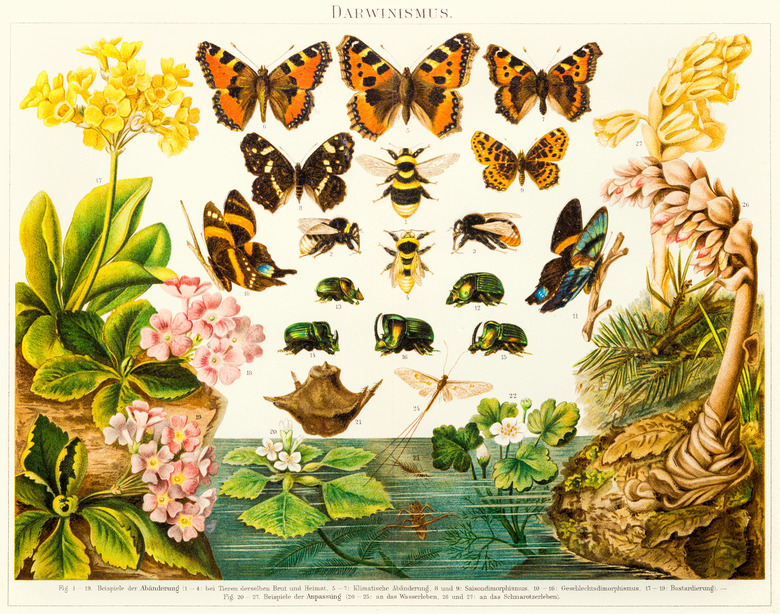What Are The Different Theories Of Evolution?
The evolution of life on Earth has been a subject of intense debate, various theories and elaborate studies. Influenced by religion, early scientists agreed with the theory of divine conception of life. With the development of natural sciences such as geology, anthropology and biology, scientists developed new theories of evolution using natural laws rather than divine instrument. Our modern understanding of evolution is the product of hundreds of years of study by many naturalists, geologists and biologists.
Evolution, But How?
Evolution, But How?
In the 18th century, Swedish botanist Carolus Linnaeus based his categorization of species on the theory of unchanging life created by God. Initially, he believed that all organisms appeared on Earth in their present form and never changed.
Linnaeus studied the organisms as wholes, and categorized them based on similarities that individuals shared. Linnaeus is known as the "father of modern taxonomy" for his work in establishing a formal naming system for organisms, in which species are assigned scientific names with two parts.
Unable to consider that organisms might change in time, he couldn't provide an explanation for the plant hybrids that resulted from cross-pollination processes with which he experimented. He concluded that life forms could evolve after all, but he could not say why or how.
Theories of Evolution
Theories of Evolution
In the late 18th century, naturalist George Louis Leclerc suggested that life on Earth was 75,000 years old and that men had descended from apes. Another step in evolution theory was taken by Erasmus Darwin, Charles Darwin's grandfather, who said the Earth was millions of years old and that species did evolve, even if he could not explain how.
Jean-Baptiste de Lamarck, the first evolutionist to publicly defend his ideas, believed that organisms had evolved constantly, from inanimate to animate organisms and on to humans. His theory was that evolution was based on a continuous chain of inherited characteristics passed from parents to offspring that had evolved with each generation until it produced the ultimate, perfect species: humans.
Catastrophism and Uniformitarianism
Catastrophism and Uniformitarianism
In the early 19th century, French scientist Georges Cuvier explained evolution through violent catastrophic events or "revolutions" that had contributed to extinction of old species and the development of species to replace them in the newly created environment. He based his theory on the discovery in the same place of fossils of different species.
Cuvier's theory was challenged by the English geologist Charles Lyell, developer of the uniformitarianism theory. He said evolution had been influenced by slow changes since the beginning of time in the shape of the terrestrial surface that could not be perceived by the human eye. This perspective was built upon by the English biologist Charles Darwin.
Charles Darwin Book
Charles Darwin Book
The mid-19th century was marked by a new theory, that of Charles Darwin, who based his theory of evolution on the concepts of natural selection and survival of the fittest. According to the Charles Darwin book, _On the Origin of Species_, published in 1859, the process of natural selection enables individuals with the most suitable characteristics in a species not only to survive, but also to transmit those characteristics to their offspring, producing evolutionary changes in the species over time as less suitable traits disappear and more suitable traits endure.
Darwin also believed that nature produces a larger-than-necessary number of individuals of a species to allow natural selection to take place. Survival of the fittest represents nature's preservation instinct to ensure that only the strongest and most well-suited individuals survive and propagate in a constantly changing environment.
Adaptations come from random genetic mutations, some of which give individuals evolutionary advantages. Populations of species continue to reproduce and adapt through the process of natural selection.
References
Cite This Article
MLA
Paduraru, Carmen. "What Are The Different Theories Of Evolution?" sciencing.com, https://www.sciencing.com/different-theories-evolution-8452154/. 30 September 2021.
APA
Paduraru, Carmen. (2021, September 30). What Are The Different Theories Of Evolution?. sciencing.com. Retrieved from https://www.sciencing.com/different-theories-evolution-8452154/
Chicago
Paduraru, Carmen. What Are The Different Theories Of Evolution? last modified August 30, 2022. https://www.sciencing.com/different-theories-evolution-8452154/
